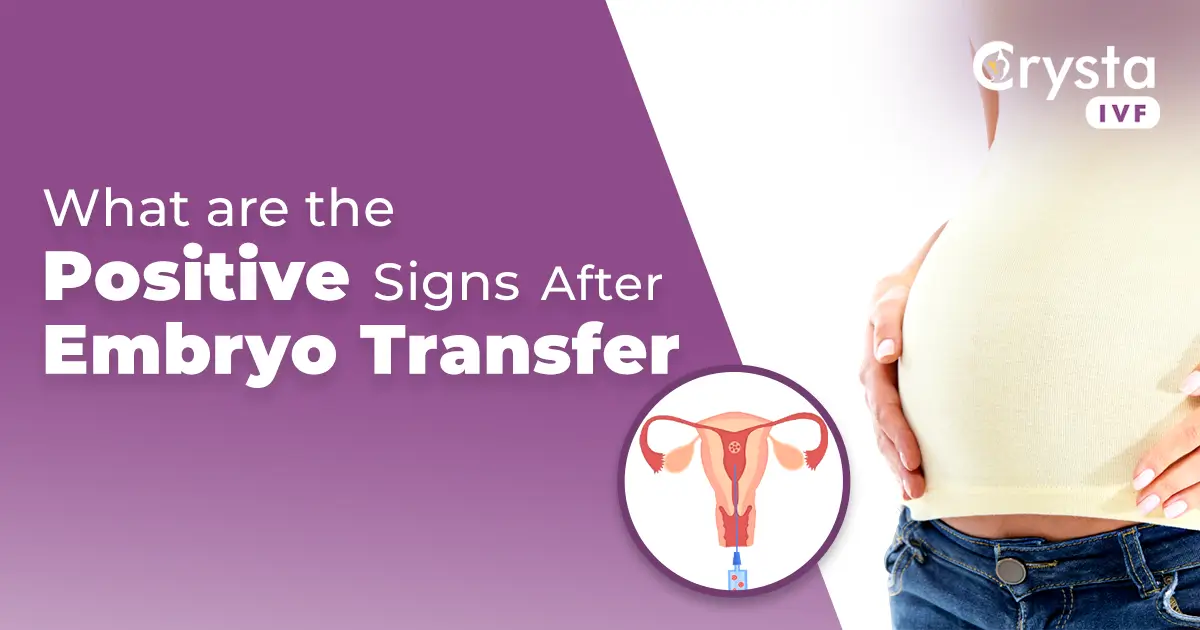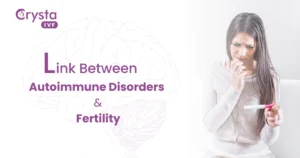After an embryo transfer, some hopeful signs may suggest successful implantation and early pregnancy. These include mild cramping, light spotting (implantation bleeding), breast tenderness, fatigue, bloating, and increased urination. Some women may also experience a rise in body temperature or heightened emotions due to hormonal changes.
However, it’s essential to remember that not everyone will experience symptoms, and their absence doesn’t necessarily mean the transfer was unsuccessful. These signs can be encouraging, but a blood pregnancy test (usually done 10–14 days after transfer) is the only reliable confirmation.
This article will explain 10 positive signs after embryo transfer that you must know. These signs can help you understand what’s happening inside your body as you wait for your pregnancy test. Remember, every woman’s experience is different, but knowing these common symptoms can give you hope and guidance during this exciting time.
How is the Embryo Transfer Done?
Embryo transfer is the final step of IVF process. It is quick and painless and doesn’t require anaesthesia in most cases. Here is how it is done:
- The embryo transfer process begins with the speculum insertion into the vagina.
- This medical device allows your doctor to monitor your vagina and cervix while keeping the vaginal walls open.
- Utilising the speculum, an IVF doctor will employ a long, thin catheter that passes through the cervix into the uterus.
- This catheter will transfer the embryos along with some fluids to help them attach to the uterine wall.
- The procedure is guided by ultrasound to ensure precision and success.
During the embryo transfer procedure, you might experience mild discomfort due to the presence of the speculum. If you have concerns about potential discomfort, it’s important to discuss them with your fertility expert.
10 Positive Signs to Look for After an Embryo Transfer
If you’ve just had an embryo transfer, you’re probably eager to know if it worked. While only a pregnancy test can confirm success, some early signs may give you hope that implantation has happened.
Here are some common positive signs many women notice:
Implantation Bleeding
Some women may experience light spotting or bleeding around six to ten days after the embryo transfer; this situation is implantation bleeding. The reason behind its occurrence is the embryo’s attachment to the uterine lining. While not all women experience this, for some, it can appear as one of the positive signs after embryo transfer, indicating that implantation has occurred.
Mild Cramping
Following the implantation bleeding, it is normal to experience gentle uterine cramps as the embryo gradually establishes itself within your uterus. Typically, these cramps are mild and distinguishable from menstrual cramps. These sensations could signify positive signs after embryo transfer.
Breast Tenderness
Breast tenderness might be one of the positive signs of embryo transfer. It typically results in early pregnancy, although some women also have cyclical breast pain due to frequent changes in their hormone levels during their menstrual cycles. Moreover, it could also be due to Injections taken during the IVF process (to increase estrogen hormone).
Missed Period
One of the most common and obvious positive signs after embryo transfer is a missed period. After conception, your body produces a hormone that obstructs ovulation and the shedding of your uterus lining. This indicates that your menstrual cycle has stopped, and you won’t have a period again after you give birth to your baby. However, a missed period is not always a sign of pregnancy; sometimes, you can also miss your period due to stress, poor diet, hormone imbalance, or excessive exercise.
Tiredness and Fatigue
Many women experience tiredness and fatigue early in their pregnancy, which can start from day one, thanks to elevated progesterone levels. Though fatigue can result from various factors, in most cases, sudden fatigue indicates a positive sign of embryo transfer. If you have found yourself lazy and getting tired more easily while doing household chores, it might be one of the positive signs after embryo transfer.
Nausea and vomiting
While it might not be the most enjoyable experience, nausea could be a positive sign after embryo transfer. This uncertainty arises due to the influence of pregnancy hormones on your body. It’s important to differentiate this from the typical nausea and vomiting associated with pregnancy, which typically occurs around four to six weeks into pregnancy.
Bloating
Experiencing a sensation of bloating in your lower abdomen, which is as equal to your premenstrual phase. This might be an encouraging sign as the effect is due to the rise in progesterone levels during early pregnancy.
However, it’s essential to be vigilant about any bloating, especially if it’s accompanied by discomfort.
Doctor’s Advice: While it’s uncommon and improbable, the combination of these symptoms could indicate ovarian hyperstimulation syndrome (OHSS). OHSS is a potentially serious condition triggered by excess hormones from injectable fertility medications, resulting in ovarian swelling. It’s worth noting that severe OHSS only impacts a small percentage (0.5% to 5%) of IVF patients. If you suspect OHSS, seek medical attention and consult your fertility expert.
Increased Vaginal Discharge
An increase in vaginal discharge following implantation might be one of the positive signs after embryo transfer. Generally, this vaginal discharge is more common in early pregnancy. The excess vaginal discharge helps prevent infections from traveling from the vagina into the uterus. Usually, healthy vaginal discharge appears thin, clear, or milky white and has a mild smell. If you have any concerns about the unusual discharge, consult your doctor.
Frequent Urination
The hormone hCG can also cause an increase in the need to urinate. You may feel the urge to pee more often because of hormonal changes and increased blood flow to the pelvic area.
Slight Fever
Some women report a slightly higher body temperature after implantation, though this isn’t always noticeable. A few experience a slightly higher temperature in the morning times which usually goes away during the day.
What are Negative Signs After Embryo Transfer?
After embryo transfer, negative results can be alarming. However, negative signs do not imply the embryo transfer has been unsuccessful. You still need to visit a doctor for confirmation.
Here are 5 negative signs after embryo transfer:
- High Menstrual Bleeding: Excessive bleeding that resembles menstruation may occur. This could potentially mean that the implantation didn’t take place.
- Severe Cramping: It’s crucial to remember that mild cramping is common with or without implantation. However, it can be a negative sign if you’re in experiencing extreme pain.
- No Increase in hCG Levels: If a blood test reveals little or no rise in hCG, it may indicate that pregnancy was not achieved.
- Pre-Menstrual Symptoms: Even in the absence of a positive pregnancy test, you may experience symptoms like PMS. It can mean that the transfer of embryos didn’t happen.
- Back Discomfort: A failed cycle may be the cause of your continuously occurring lower back discomfort.
When to Take a Pregnancy Test After Embryo Transfer?
You can take a pregnancy test after waiting at least two weeks (10-14 days) after the embryo transfer. However, it is best to consult your fertility doctor and follow their guidance.
A pregnancy test examines Human Chorionic Gonadotropin (a hormone produced only in pregnancy). After embryo implantation, the hCG hormone starts to appear more and more, so it takes time for the hCG hormone to appear in a pregnancy test. Due to this condition, a pregnancy test is recommended around two weeks after testing too early may lead to a negative result.
No Symptoms After Embryo Transfer? Here’s What Doctors Advise
Don’t worry if you read this list and find that none of these apply to you after you have undergone embryo transfer. The absence of certain signs does not imply that the embryo transfer was unsuccessful.
According to Crysta IVF expert doctors, “The presence or absence of these symptoms is nonspecific and does not predict pregnancy outcome. You have to undergo a pregnancy test or a blood test to get confirmation about your pregnancy.”
According to Healthline, 10 -15% of patients have no symptoms at all, but still have a positive pregnancy test. A positive pregnancy test is the only reliable indicator that your embryo transfer was successful.
To Sum Up
Remember that every woman’s body is unique, and experiences vary widely. While these signs can offer hope and optimism, the only surefire way to confirm pregnancy is through a blood test or ultrasound administered by a fertility specialist.
The two-week wait can be challenging, but staying positive and seeking support from your medical team, loved ones, and the best IVF clinic in Patna can help you navigate this crucial phase with optimism and patience. So, don’t worry about your IVF journey; your path to parenthood is about to start!
Frequently Asked Questions
What symptoms can be noticed 7 days after embryo transfer?
Around day 7, some women notice light spotting, mild cramping, bloating, sore breasts, fatigue, or increased discharge, which could be early signs of implantation.
How does the body change after an embryo transfer?
After transfer, your body produces more progesterone and estrogen to support pregnancy. You might feel more tired, bloated, and notice breast tenderness, and sometimes mild pelvic discomfort.
Is passing gas normal after an embryo transfer?
Yes, feeling gassy or bloated is common after embryo transfer. Hormonal changes and stress can slow digestion, leading to more gas. It doesn’t harm implantation.
Do the symptoms of a positive embryo transfer start right after the procedure?
No, it usually takes 5-10 days for the embryo to implant and for symptoms to appear.
Apart from symptoms, are there ways to know if the embryo transfer was successful?
The only reliable way to confirm is through a blood test (beta hCG) about 10–14 days after transfer. Symptoms alone are not conclusive.
Is leg pain after an embryo transfer normal?
Mild leg discomfort can happen due to hormonal changes or lying down for long periods, but severe pain should be reported to a doctor right away.
Is watery discharge after embryo transfer a good sign?
Yes, watery discharge after embryo transfer is a good sign if it’s foul-smelling or accompanied by itching.
Does no symptom mean the transfer didn’t work?
No, not necessarily. Many women feel no symptoms and still have a successful pregnancy. Everybody reacts differently to embryo transfer.
Does spotting always mean implantation?
No, not always, it could also be from the procedure or medications. Only a blood test confirms pregnancy.
Can mild cramps after transfer be a good sign?
Yes, mild cramps are common and can indicate that the uterus is adjusting or that implantation is happening.
Do progesterone shots cause pregnancy-like symptoms even if not pregnant?
Yes, progesterone can mimic pregnancy symptoms like fatigue, bloating, and breast tenderness.
Does having a lot of discharge mean I’m pregnant?
No, the increased discharge can be a good sign, but it also happens due to hormonal medications.
Should I avoid exercise or movement if I feel symptoms?
No, you can continue light activity unless your doctor advises bed rest. Symptoms don’t mean you need to stop moving completely.
Also, read – https://crystaivf.com/blogs/when-should-you-take-a-pregnancy-test/




